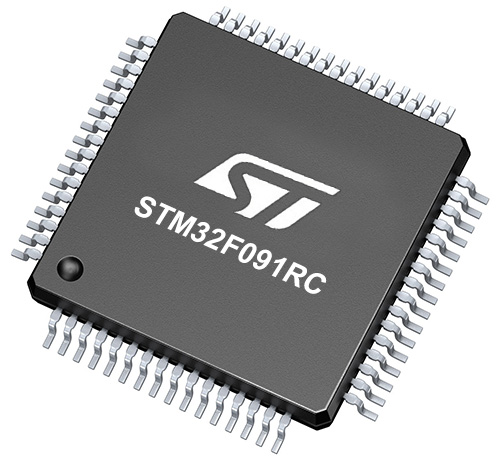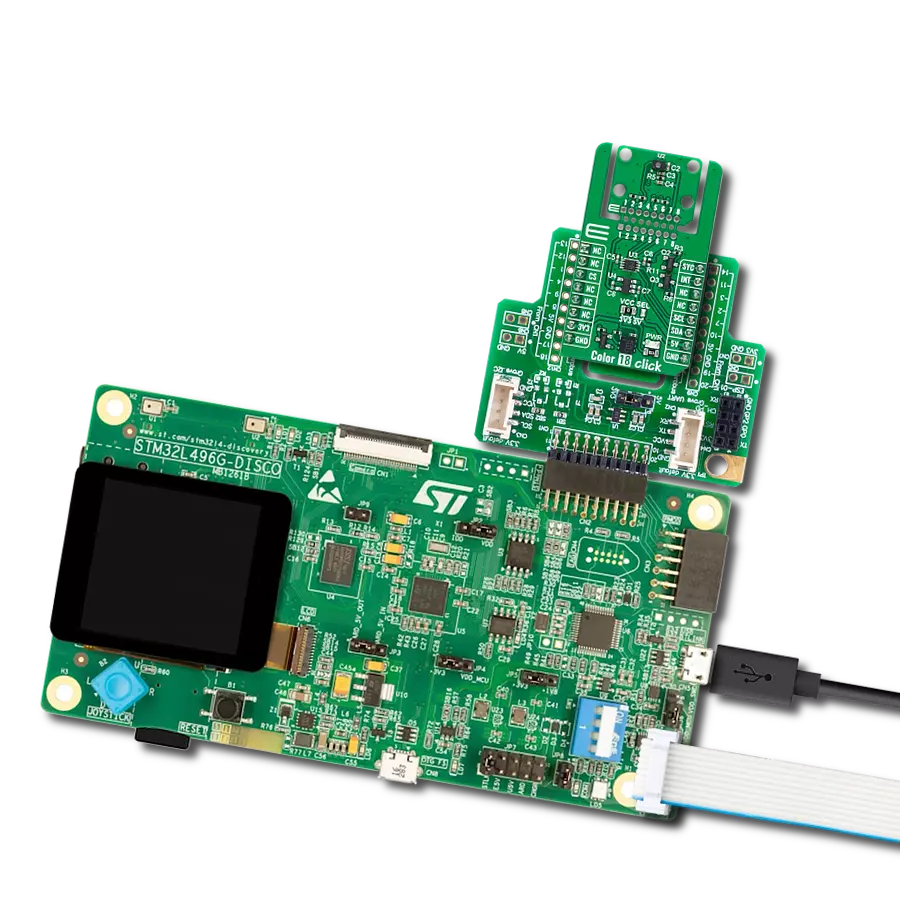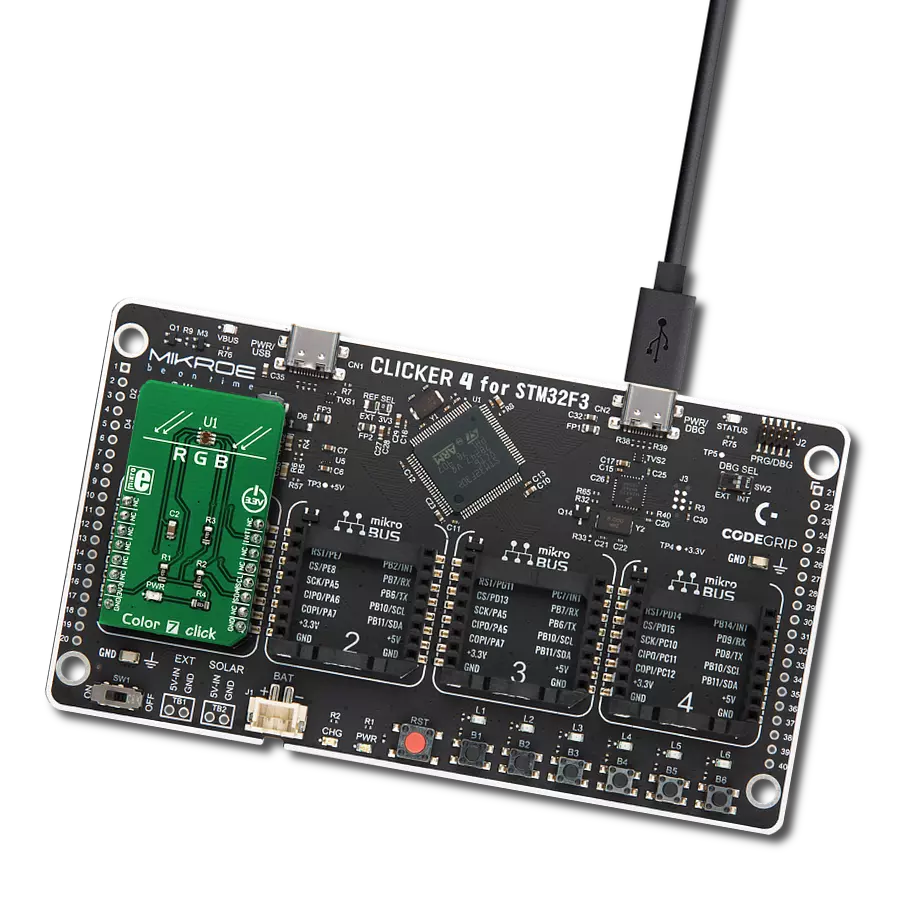Elevate security systems to new heights with our advanced multizone ranging sensor. Covering a 90° wide area and boasting a range of up to 350cm, it ensures comprehensive and accurate surveillance, enhancing situational awareness and response capabilities.
A
A
Hardware Overview
How does it work?
LightRanger11 Click is based on the VL53L7CX, a time-of-flight 8x8 multizone ranging sensor from STMicroelectronics. This ToF sensor integrates a VCSEL (vertical-cavity surface-emitting laser), which emits an entirely invisible 940nm IR light, totally safe for eyes (Class 1 certification), and a SPAD (single-photon avalanche diode) array which helps the VL53L7CX to achieve the best-ranging performance even when a Click board™ is hidden behind a wide range of cover glass materials. In addition, the sensor is equipped with diffractive optical elements (DOE) on both the transmitter and the receiver, enabling square FoV. Designed explicitly for small-range and multi-target measurements, the VL53L7CX provides very accurate distance measurements up to 350cm with excellent results over short distances and
60°x60° square field of view (FoV) (90° diagonal), which improves performances under ambient light. Thanks to ST's patented algorithms, the VL53L7CX can detect multiple objects within the FoV with depth understanding. ST histogram algorithms ensure cover glass crosstalk immunity beyond 60cm. Like all Time-of-Flight sensors based on ST's FlightSense technology, the VL53L7CX records an absolute distance measurement regardless of the target color and reflectance. LightRanger 11 Click uses a standard 2-Wire I2C interface to communicate with the host MCU, read data, and configure settings with a maximum clock frequency of up to 1MHz. The I2C interface on Click board™ can be reset through the RSC pin of the mikroBUS™ socket, hence offering a switch operation to turn ON the initial
I2C starting sequence of the VL53L7CX. It also possesses an additional interrupt pin, routed to the INT pin on the mikroBUS™ socket, indicating when a ranging measurement is available. An LP pin lets you turn the I2C communication on or off when in low power mode, which is used when changing the I2C address in multi-device systems. This Click board™ can be operated only with a 3.3V logic voltage level. The board must perform appropriate logic voltage level conversion before using MCUs with different logic levels. Also, this Click board™ comes equipped with a library containing easy-to-use functions and an example code that can be used as a reference for further development.
Features overview
Development board
Nucleo-64 with STM32F091RC MCU offers a cost-effective and adaptable platform for developers to explore new ideas and prototype their designs. This board harnesses the versatility of the STM32 microcontroller, enabling users to select the optimal balance of performance and power consumption for their projects. It accommodates the STM32 microcontroller in the LQFP64 package and includes essential components such as a user LED, which doubles as an ARDUINO® signal, alongside user and reset push-buttons, and a 32.768kHz crystal oscillator for precise timing operations. Designed with expansion and flexibility in mind, the Nucleo-64 board features an ARDUINO® Uno V3 expansion connector and ST morpho extension pin
headers, granting complete access to the STM32's I/Os for comprehensive project integration. Power supply options are adaptable, supporting ST-LINK USB VBUS or external power sources, ensuring adaptability in various development environments. The board also has an on-board ST-LINK debugger/programmer with USB re-enumeration capability, simplifying the programming and debugging process. Moreover, the board is designed to simplify advanced development with its external SMPS for efficient Vcore logic supply, support for USB Device full speed or USB SNK/UFP full speed, and built-in cryptographic features, enhancing both the power efficiency and security of projects. Additional connectivity is
provided through dedicated connectors for external SMPS experimentation, a USB connector for the ST-LINK, and a MIPI® debug connector, expanding the possibilities for hardware interfacing and experimentation. Developers will find extensive support through comprehensive free software libraries and examples, courtesy of the STM32Cube MCU Package. This, combined with compatibility with a wide array of Integrated Development Environments (IDEs), including IAR Embedded Workbench®, MDK-ARM, and STM32CubeIDE, ensures a smooth and efficient development experience, allowing users to fully leverage the capabilities of the Nucleo-64 board in their projects.
Microcontroller Overview
MCU Card / MCU

Architecture
ARM Cortex-M0
MCU Memory (KB)
256
Silicon Vendor
STMicroelectronics
Pin count
64
RAM (Bytes)
32768
You complete me!
Accessories
Click Shield for Nucleo-64 comes equipped with two proprietary mikroBUS™ sockets, allowing all the Click board™ devices to be interfaced with the STM32 Nucleo-64 board with no effort. This way, Mikroe allows its users to add any functionality from our ever-growing range of Click boards™, such as WiFi, GSM, GPS, Bluetooth, ZigBee, environmental sensors, LEDs, speech recognition, motor control, movement sensors, and many more. More than 1537 Click boards™, which can be stacked and integrated, are at your disposal. The STM32 Nucleo-64 boards are based on the microcontrollers in 64-pin packages, a 32-bit MCU with an ARM Cortex M4 processor operating at 84MHz, 512Kb Flash, and 96KB SRAM, divided into two regions where the top section represents the ST-Link/V2 debugger and programmer while the bottom section of the board is an actual development board. These boards are controlled and powered conveniently through a USB connection to program and efficiently debug the Nucleo-64 board out of the box, with an additional USB cable connected to the USB mini port on the board. Most of the STM32 microcontroller pins are brought to the IO pins on the left and right edge of the board, which are then connected to two existing mikroBUS™ sockets. This Click Shield also has several switches that perform functions such as selecting the logic levels of analog signals on mikroBUS™ sockets and selecting logic voltage levels of the mikroBUS™ sockets themselves. Besides, the user is offered the possibility of using any Click board™ with the help of existing bidirectional level-shifting voltage translators, regardless of whether the Click board™ operates at a 3.3V or 5V logic voltage level. Once you connect the STM32 Nucleo-64 board with our Click Shield for Nucleo-64, you can access hundreds of Click boards™, working with 3.3V or 5V logic voltage levels.
Used MCU Pins
mikroBUS™ mapper
Take a closer look
Click board™ Schematic

Step by step
Project assembly
Track your results in real time
Application Output
1. Application Output - In Debug mode, the 'Application Output' window enables real-time data monitoring, offering direct insight into execution results. Ensure proper data display by configuring the environment correctly using the provided tutorial.

2. UART Terminal - Use the UART Terminal to monitor data transmission via a USB to UART converter, allowing direct communication between the Click board™ and your development system. Configure the baud rate and other serial settings according to your project's requirements to ensure proper functionality. For step-by-step setup instructions, refer to the provided tutorial.

3. Plot Output - The Plot feature offers a powerful way to visualize real-time sensor data, enabling trend analysis, debugging, and comparison of multiple data points. To set it up correctly, follow the provided tutorial, which includes a step-by-step example of using the Plot feature to display Click board™ readings. To use the Plot feature in your code, use the function: plot(*insert_graph_name*, variable_name);. This is a general format, and it is up to the user to replace 'insert_graph_name' with the actual graph name and 'variable_name' with the parameter to be displayed.

Software Support
Library Description
This library contains API for LightRanger 11 Click driver.
Key functions:
lightranger11_get_ranging_data- LightRanger 11 get ranging data function.lightranger11_get_resolution- LightRanger 11 get resolution function.lightranger11_get_int_pin- LightRanger 11 get int pin function.
Open Source
Code example
The complete application code and a ready-to-use project are available through the NECTO Studio Package Manager for direct installation in the NECTO Studio. The application code can also be found on the MIKROE GitHub account.
/*!
* @file main.c
* @brief LightRanger 11 Click example
*
* # Description
* This example demonstrates the use of LightRanger 11 Click board by reading and displaying
* 8x8 zones measurements on the USB UART.
*
* The demo application is composed of two sections :
*
* ## Application Init
* Initializes the driver and performs the Click default configuration.
*
* ## Application Task
* Reads all zone measurements approximately every 500ms and logs them to the USB UART as an 8x8 map.
* The silicon temperature measurement in degrees Celsius is also displayed.
*
* @author Nenad Filipovic
*
*/
#include "board.h"
#include "log.h"
#include "lightranger11.h"
static lightranger11_t lightranger11;
static log_t logger;
void application_init ( void )
{
log_cfg_t log_cfg; /**< Logger config object. */
lightranger11_cfg_t lightranger11_cfg; /**< Click config object. */
/**
* Logger initialization.
* Default baud rate: 115200
* Default log level: LOG_LEVEL_DEBUG
* @note If USB_UART_RX and USB_UART_TX
* are defined as HAL_PIN_NC, you will
* need to define them manually for log to work.
* See @b LOG_MAP_USB_UART macro definition for detailed explanation.
*/
LOG_MAP_USB_UART( log_cfg );
log_init( &logger, &log_cfg );
log_info( &logger, " Application Init " );
// Click initialization.
lightranger11_cfg_setup( &lightranger11_cfg );
LIGHTRANGER11_MAP_MIKROBUS( lightranger11_cfg, MIKROBUS_1 );
if ( I2C_MASTER_ERROR == lightranger11_init( &lightranger11, &lightranger11_cfg ) )
{
log_error( &logger, " Communication init." );
for ( ; ; );
}
if ( LIGHTRANGER11_ERROR == lightranger11_default_cfg ( &lightranger11 ) )
{
log_error( &logger, " Default configuration." );
for ( ; ; );
}
log_info( &logger, " Application Task " );
}
void application_task ( void )
{
if ( !lightranger11_get_int_pin ( &lightranger11 ) )
{
lightranger11_results_data_t results;
uint8_t resolution, map_side;
err_t error_flag = lightranger11_get_resolution ( &lightranger11, &resolution );
error_flag |= lightranger11_get_ranging_data ( &lightranger11, &results );
if ( LIGHTRANGER11_OK == error_flag )
{
map_side = ( LIGHTRANGER11_RESOLUTION_4X4 == resolution ) ? 4 : 8;
log_printf ( &logger, "\r\n %ux%u MAP (mm):\r\n", ( uint16_t ) map_side, ( uint16_t ) map_side );
for ( uint16_t cnt = 1; cnt <= resolution; cnt++ )
{
log_printf ( &logger, " %u\t", results.distance_mm[ cnt - 1 ] );
if ( 0 == ( cnt % map_side ) )
{
log_printf ( &logger, "\r\n" );
}
}
log_printf ( &logger, " Silicon temperature : %d degC\r\n", ( int16_t ) results.silicon_temp_degc );
}
}
}
int main ( void )
{
/* Do not remove this line or clock might not be set correctly. */
#ifdef PREINIT_SUPPORTED
preinit();
#endif
application_init( );
for ( ; ; )
{
application_task( );
}
return 0;
}
// ------------------------------------------------------------------------ END

































